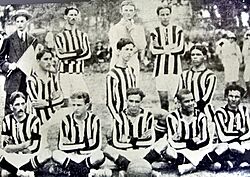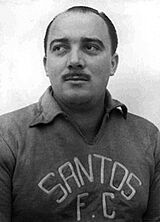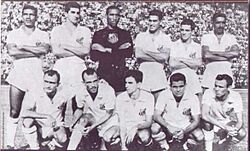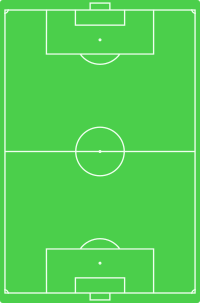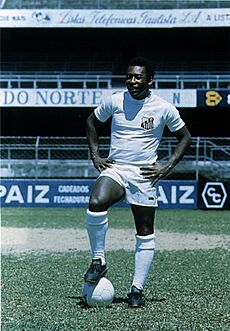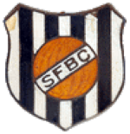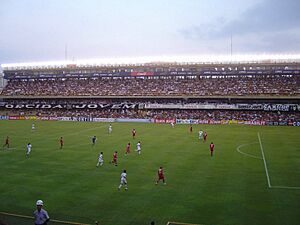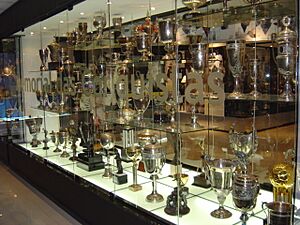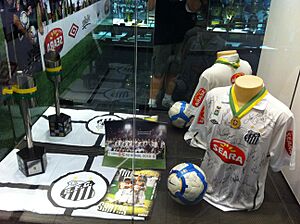Santos FC facts for kids
 |
||||
| Full name | Santos Futebol Clube | |||
|---|---|---|---|---|
| Nickname(s) | Peixe (Fish) Alvinegro (Black-and-White) Alvinegro Praiano (Black-and-White from the Beach) Santástico (Fantastic Santos) |
|||
| Founded | 14 April 1912 | |||
| Stadium | Vila Belmiro | |||
| Capacity | 16,068 | |||
| President | Marcelo Teixeira | |||
| Head coach | Cleber Xavier | |||
| League | Campeonato Brasileiro Série A Campeonato Paulista |
|||
| 2022 2023 |
Série A, 12th of 20 Paulista, 12th of 16 |
|||
|
||||
Santos Futebol Clube is a famous Brazilian sports club. It is based in Vila Belmiro, a neighborhood in the city of Santos. The team plays in the Campeonato Paulista, which is the top league in the state of São Paulo. They also play in the Campeonato Brasileiro Série A, which is Brazil's highest national football league. Santos earned their spot back in Série A after winning the 2024 Série B title.
The club was started in 1912 by three sports fans from Santos: Raimundo Marques, Mário Ferraz de Campos, and Argemiro de Souza Júnior. They wanted their city to have a strong football team. Santos quickly became one of Brazil's most successful clubs. It is known for its beautiful style of play, called Joga Bonito. Their motto is "Técnica e Disciplina," meaning "technique and discipline." This style was made famous by their amazing team in the 1960s. This "golden generation" included legendary players like Gilmar, Mauro Ramos, Mengálvio, Coutinho, Pepe, and the greatest of all, Pelé. Pelé was even called the "Athlete of the Century" by the International Olympic Committee.
This incredible team, known as Os Santásticos, is thought by many to be one of the best club teams ever. They won 24 titles in the 1960s, including five league titles in a row. In 1962, Os Santásticos won four major competitions: the Campeonato Paulista, the Campeonato Brasileiro Série A, the Copa Libertadores, and the European/South American Cup.
Santos Futebol Clube has won the Brasileirão (Brazilian league) eight times. They also have 22 Paulistão (state league) titles, three Copa Libertadores, and two Intercontinental Cups. In 1998, Santos was the first team in the world to score 10,000 goals in its history. FIFA also named them one of the most successful clubs of the 20th century.
The team plays its home games at the Vila Belmiro. This stadium can hold up to 20,120 fans. Santos' home uniform is white shirts, white shorts, and white socks. The club's nickname is Peixe (pronounced "peyshee"), which means "fish" in Portuguese. This nickname refers to the city's important port. Santos has big rivalries with other major clubs like Corinthians, Palmeiras, and São Paulo.
Contents
- Club History
- How Santos FC Started: 1912
- Early Years and First Wins: 1912–1935
- Building for Success: 1936–1955
- The Golden Era: Os Santásticos (1956–1974)
- Ups and Downs: 1974–1994
- The 1990s and New Challenges: 1995–2002
- The Reborn Peixe: 2002–2008
- The Second Santástico Era: 2009–2013
- Financial Struggles and Relegation: 2014–2024
- Back to Série A and Neymar's Return: 2025–Present
- Team Colors and Crest
- Sponsorship
- Stadiums
- Club Brand and Influence
- Supporters
- Rivalries
- Players
- Club Staff
- Club Achievements
- Statistics and Records
- Other Sports Sections
- See also
- Movies About Santos FC
Club History
How Santos FC Started: 1912
In the early 1900s, the city of Santos became very important for Brazil. Its port grew into one of the world's largest. Coffee was a major product exported from there. With more money coming in, wealthy people in the city wanted Santos to have strong sports teams. Water sports like rowing were popular, but the city also had football teams. However, the two strongest teams, Clube Atlético Internacional and Sport Club Americano, either stopped playing or moved away.
Because of this, students in Santos decided to create a new football team. They held a long meeting to decide on a name. Many ideas came up, but everyone agreed on Santos Foot-Ball Club. The club officially started on April 14, 1912. It was founded just hours before the famous RMS Titanic sank. People often say, "One Giant sank into the ocean, and on the same day Another One was born." The club's first president was Sizino Patuska.
Early Years and First Wins: 1912–1935
Santos played its first practice match on June 23, 1912, winning 2–1. The first official game was on September 15, 1912, where Santos won 3–2. The team joined the Campeonato Paulista in 1913. They had some tough losses and high travel costs, so they left the tournament to improve.
In 1913, Santos won its first title, the Campeonato Santista. They won all six matches, scoring 35 goals. In 1914, due to money problems, Santos only played friendly games, winning all seven. In 1915, they temporarily changed their name to União Futebol Clube to play in another city tournament and won again. With better finances, the Vila Belmiro stadium opened on October 12, 1916. Santos returned to the Campeonato Paulista that year and finished in a much better 5th place.
Between 1917 and 1926, Santos was a good team but couldn't win the state title. That changed in 1927. The team became known as O ataque dos 100 gols (The 100-goal attackers). They were led by Araken Patusca, who was the son of Santos' first president. Araken Patusca was the first Santos player to play in a World Cup, joining the Brazilian national team in the 1930 FIFA World Cup. Santos finished second in 1927, 1928, and 1929. In 1927, they scored 100 goals in just 16 games, which is an amazing 6.25 goals per match! This showed their focus on "Technique and Discipline."
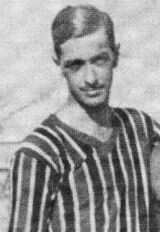
Santos had some ups and downs as they became a professional team. In 1935, they won their first state title ever. They beat Corinthians 2–0 in the final game, with goals from Raul and Araken Patusca. This was a huge moment for the club. Even though they didn't win the state title the next year, Santos remained unbeaten in international matches during the 1930s. They even beat the France national football team 6–1!
Building for Success: 1936–1955
After winning in 1935, many key players left or retired. Santos struggled for about 10 years. However, things changed when former goalkeeper Athié Jorge Cury became club president in 1946. He worked to improve the club's finances and sent the team on a tour to northern and northeastern Brazil. This trip helped the younger players gain experience. Santos went undefeated on this tour, winning 12 games and drawing three.
The club finished second in the 1948 Paulistão, led by players like Antoninho and Odair. Odair was the top scorer for the club for four seasons in a row. Santos also played in the Torneio Rio – São Paulo for the first time in 1952, finishing third. New young talents like Zito and Vasconcelos joined the team. Antoninho became an assistant manager in 1954, and Lula became the head coach.
In 1955, Santos built the foundation for its future success. They won their second state title, the first in 20 years. Emanuele Del Vecchio was the top scorer with 38 goals. To keep the team strong, President Cury signed important players like Zito and young talents like Pepe and Pagão. The most important signing was a 15-year-old boy named Edson Arantes do Nascimento, who would soon be known as Pelé. Pelé joined Santos in June 1956.
The Golden Era: Os Santásticos (1956–1974)
After 50 years, Santos became known as the best team in the world. When Pelé started playing in the Campeonato Paulista in 1957, the team had already won two state titles. With Pelé and other stars like Zito and Pepe, Santos won their third state title in 1958. This was the same year Brazil won the World Cup in Sweden, with Santos players Zito, Pelé, and Pepe on the national team. Santos scored an amazing 143 goals in 38 games in 1958, averaging 3.76 goals per game. Pelé set a record by scoring 58 goals in that season. They even beat Nacional 10–0! Santos also won the Rio-São Paulo tournament in 1959.
Winning Everything: The First Continental Treble
No other team in Brazil was as dominant as Santos in the 1960s. The club won eight national titles, two Copas Libertadores, and two Intercontinental Cups. Many experts from South America and Europe chose the Santos team of 1962/63 as the best team of all time.
Santos became famous worldwide and played exhibition matches in many countries. It's even said that a war in Africa stopped so people could watch Pelé's team play! Santos players were a big part of the Brazilian World Cup teams in 1962 and 1970. Sometimes, eight Santos players were on the national team at once.
The Os Santásticos era ended, but Santos continued to win. They were champions in 1973, still with Pelé. In 1978, a new group of young stars, called Meninos da Vila (Boys from the Village), led the team. These players, like Pita and Juary, made Santos a symbol of passion for fans.
Ups and Downs: 1974–1994
After the golden era, Santos faced some financial challenges. However, the club's strong fan base kept its spirit alive. In 1980, Santos finished second in the São Paulo state championship. A player named Serginho became a big idol for Santos during this time. He was a powerful striker and helped Santos reach the final of the Brazilian Championship in 1983, where they finished second.
In 1984, Santos won the São Paulo state championship again. They beat Corinthians 1–0 in the final game, with Serginho scoring the winning goal. Serginho was also the top scorer that season.
The 1990s and New Challenges: 1995–2002
In the 1990s, Santos won only two major titles: the Rio – São Paulo Tournament in 1997 and the Copa CONMEBOL in 1998. In the 1995 national championship final, Santos lost to Botafogo.
The new chairman, Marcelo Teixeira, tried to build a strong team for the 21st century. They brought in many famous players, but these big names didn't always lead to success on the field. Santos finished second in the state championships in 2000 and 2001, but their national league performance was not as good.
The Reborn Peixe: 2002–2008
In 2002, Santos was in serious financial trouble. They decided to let go of expensive players and focus on their youth teams. They brought in young talents like Robinho and Diego from their youth setup. These young players, along with others like Elano and Léo, became key players under new coach Emerson Leão.
Santos had a great season in 2002, finishing eighth in the regular season and qualifying for the playoffs. They beat São Paulo and Grêmio to reach the final. With Robinho and Diego leading the way, Santos beat Corinthians in both final games to win their seventh national championship. Robinho's famous "pedalada" (a dribbling trick) became very popular during this final.
In 2003, Santos finished second in the national championship. In 2004, they won their eighth national title. Despite challenges like playing away from their home stadium and a referee scandal where some matches had to be replayed, Santos showed great strength and won the championship.
In 2006, Santos won the Paulista Championship for the first time since 1984. They won it again in 2007. In 2008, Santos faced difficulties and barely avoided relegation. They also reached the quarter-finals of the Copa Libertadores.
The Second Santástico Era: 2009–2013
Santos faced financial problems again, so they focused on young players. In 2009, Neymar and Paulo Henrique Ganso joined the main team. Neymar had been with Santos since he was 13, and Ganso since he was 15. They became a strong duo. In 2010, they led a fantastic team that won the Campeonato Paulista and the Copa do Brasil. They had an amazing campaign, including a 10–0 win against Naviraiense. This team was called Santástico again because of their exciting style and dancing celebrations.
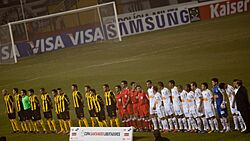
2011 was another great year. Santos won the Campeonato Paulista again, beating rivals São Paulo and Corinthians. This team also won the Copa Libertadores, beating Peñarol from Uruguay in the finals. In December, Santos played in the FIFA Club World Cup in Japan and finished second, losing to Barcelona.
In 2012, Santos continued its winning streak, taking home the State Championships (Paulistão) and the Recopa Sudamericana. However, the team started to break apart as key players like Ganso and Borges left.
The latest Santástico era ended in 2013. Santos didn't win their fourth Paulistão in a row, finishing second. The biggest change was the departure of Neymar, who moved to Barcelona. Coach Muricy Ramalho and goalkeeper Rafael Cabral also left. Santos finished seventh in the 2013 season.
Financial Struggles and Relegation: 2014–2024
In 2014, Santos signed Leandro Damião, their most expensive player ever. On February 1, Gabriel, another youth player, scored Santos' 12,000th goal. Santos played well in the Paulistão but lost the final on penalty kicks. Later that year, coach Oswaldo de Oliveira was replaced by Enderson Moreira.
Santos finished 9th in the 2014 Brasileirão. The club also had many financial problems from the previous management. Several players took legal action because they weren't paid.
In 2015, due to money issues, former players Elano and Ricardo Oliveira returned to Santos for lower wages. On March 5, Enderson Moreira was fired. Marcelo Fernandes took over and won the Paulistão that year. After a tough start in the Brasileirão, Dorival Júnior returned as coach. He led the team to the finals of the 2015 Copa do Brasil and improved their league position.
Dorival continued as coach in 2016, winning the Paulistão again. In 2017, Dorival was sacked, and Levir Culpi took over, but he was also dismissed due to poor results.
In 2019, Santos hired famous coach Jorge Sampaoli. He led the club to second place in the league. However, they were knocked out early in other cup competitions. Sampaoli later resigned. Jesualdo Ferreira became coach in 2020 but was sacked in August. Cuca returned as manager.

Santos faced several bans from FIFA in 2020 because they didn't pay debts to some players. These bans led to many young players making their debut, including Ângelo at just 15 years old. In December 2020, Andrés Rueda was elected as the new president.
In January 2021, Santos reached the final of the 2020 Copa Libertadores but lost to rivals Palmeiras. Coach Cuca left, and Ariel Holan was hired, but he resigned in April. Fernando Diniz then became manager but was dismissed in September. Fábio Carille finished the season as manager. Carille was sacked in February 2022, and Fabián Bustos took his place.
On the final day of the 2023 season, Santos lost to Fortaleza and finished 17th. This meant they were relegated to the Campeonato Brasileiro Série B for the first time in their 111-year history. On December 9, 2023, Marcelo Teixeira was elected president again.
For the 2024 season, their first in the second division, Carille returned as head coach. He led the team to the 2024 Campeonato Paulista finals and helped them win the Série B title with two games left. Carille was sacked on November 18, 2024, before the final match of the season.
Back to Série A and Neymar's Return: 2025–Present
For the 2025 season, Pedro Caixinha was hired as the new head coach. On January 31, 2025, the club announced that Neymar had returned to Santos on a five-month contract.
Team Colors and Crest
|
|
| First kit (1912) |
The first colors chosen for Santos were white, azure blue, and golden lemon. These colors honored the Concórdia Club, which allowed Santos to use their headquarters. However, it was hard to make uniforms with these colors back then. So, a year after the club started, they decided to change the official colors to white and black. White represents peace, and black represents nobility.
Santos has had eight main crests (logos) since it was founded. The first one in 1912 was a black and white striped shield with an old leather football in the middle. It had a diagonal band with the letters "SFBC." Over the years, the crest changed several times. In 1913, it was redesigned as a badge inside a globe with "S.F.C." on a black diagonal band.
In 1925, the globe and crown were removed, and the crest took on a shape similar to its current form. On December 27, 2022, a crown was added to the crest above the two stars. This was done to honor Pelé, who passed away two days later. The crown is a permanent tribute to "O Rei" Pelé.
Sponsorship
| Nation | Corporation |
|---|---|
| Material manufacturers | |
| Umbro | |
| Financial sponsors | |
| SumUp | |
| Brahma | |
| Casa de Apostas | |
| Foxlux | |
| Kicaldo | |
| Kodilar | |
| Philco | |
| Tekbond Saint-Gobain | |
Since 1979, Santos has had many different sponsors. Rainha was the club's first uniform maker. Casas Bahia, a Brazilian store for furniture and home appliances, was the first main sponsor. Currently, Umbro makes the team's uniforms.
Santos also has other sponsors that invest in the club. These include Caixa (a Brazilian bank), Brahma (a popular beer in Brazil), Semp, and Algar Telecom (a Brazilian phone company).
Stadiums
After Santos FC was founded, they trained in a field in the Macuco district. But this field was too small for official matches. So, Santos played at the "Igreja Coração de Maria" pitch. However, other clubs also used this field, causing problems. To fix this, the club decided to buy its own land. On May 31, 1916, they bought a large area in Vila Belmiro. On October 12 of that year, the Vila Belmiro sports park officially opened. The first game there was on October 22, 1916, which Santos won 2–1.
The stadium's capacity has changed over time. It once held 32,989 fans in a game against Corinthians in 1964. Modern updates have reduced its size. In 1998, a new lighting system was installed. The Vila Belmiro has hosted important matches, including the 1949 Copa América, the 1962 Copa Libertadores final, and the 1998 Copa CONMEBOL final. It also hosted a Copa do Brasil final in 2010. Because Vila Belmiro has a smaller capacity, Santos sometimes uses larger stadiums in São Paulo, like Pacaembu and Morumbi, or even the Maracanã in Rio de Janeiro, for big games.
In October 2005, the Centro de Treinamento Rei Pelé (King Pelé Training Center) opened. This modern training ground has medical and training facilities for the first team. The Centro de Treinamento Meninos da Vila (Boys from the Village Training Center) opened in August 2006. It has two fields the same size as Vila Belmiro and is used for training young players.
Club Brand and Influence
Santos' global fame comes from the success of Os Santásticos, led by coach Lula. This iconic team, with players like Gilmar, Mauro, Mengálvio, Coutinho, Pepe, and Pelé, gained worldwide attention. This popularity has led to many clubs around the world being named after Santos. For example, there are Santos Futebol Clube teams in Macapá, João Pessoa, and Angola. There's also Santos F.C. in Guyana and Jamaica.
Youth soccer academies named "Santos FC Academy" exist in places like Oak Park, California, and Orlando, Florida, in the United States. In Iwata, Japan, the "Santos FC Soccer Academy Japan" has been popular since 1993. The club also expanded its brand to Cairo, Egypt, in 2008.
Santos is one of Brazil's most financially strong football clubs. In 2011, their team was the most valuable in South America. The video game Pro Evolution Soccer 2012 featured Santos, which was the first time the club appeared in a video game. The team's exciting, attacking style of play made Santos travel to over 50 countries. The club's focus on success both on and off the field brought in a lot of money. The strength of the Santos brand was greatly boosted by its FIFA World Cup winners, especially Pelé. Pelé is a national hero in Brazil. He is known for his achievements in football and for supporting policies to help poor children. He was called "The King of Football" (O Rei do Futebol). In 2013, Santos signed Pelé to be its global ambassador, making it a lifetime contract in 2014. They continue to use his image in their marketing.
Supporters
Santos is one of the most popular clubs in Brazil. They have fans in all Brazilian states and in many countries worldwide. A survey in 2006 showed that Santos was the fourth most popular football club in Brazil, with about 10 million fans. It is estimated that Santos FC has nearly 20 million fans globally.
There are also several organized fan clubs for Santos, such as Torcida Jovem do Santos, Sangue Jovem, and Força Jovem Santos. Santos is one of the clubs with the most members in Brazil, currently having over 70,000 members.
Rivalries
Santos doesn't have a close rival in its own city. So, its biggest rivalries are with clubs from nearby São Paulo city: Corinthians, São Paulo, and Palmeiras.
- The derby between Santos and São Paulo is called "San–São". It's one of Brazil's biggest derbies because both teams have won many international titles, including three Copa Libertadores each.
- The rivalry with Palmeiras is known as "Clássico da Saudade" (Nostalgia Derby). This is because in the 1960s, both teams had amazing players and often played against each other in championship finals.
- The rivalry with Corinthians is called "Clássico Alvinegro" (the Black and White Derby). This name comes from the black and white colors that both teams wear.
Players
Brazilian teams can have up to five players who are not Brazilian citizens in each match. The list below shows the main nationality of each player. Some players might have dual citizenship.
Current Squad
|
|
Youth Team Players
|
|
Players on Loan to Other Clubs
|
|
Club Staff
Current Coaching Team
| Position | Staff |
|---|---|
| Head coach | |
| Assistant coach | |
| Fitness coach | |
| Goalkeeper coach | |
| Performance analyst | |
| Physiotherapist | |
| Physiologist | |
| Doctor | |
| Nutritionist |
Last updated: 1 May 2025
Source: Santos FC
Club Management
| Office | Name |
|---|---|
| President | Marcelo Teixeira |
| Vice president | Fernando Bonavides |
| CEO | Pedro Martins |
| Youth football director | José Renato Quaresma |
Last updated: 21 January 2025
Source: Santos FC
Club Achievements
Santos is Brazil's fourth most successful team, with nine national trophies. They are also one of the most famous football clubs in the world, having won eight international trophies. This makes them the seventh most successful team in South America in official international competitions.
Official Titles
| Worldwide Competitions | ||
|---|---|---|
| Competitions | Titles | Seasons |
| Intercontinental Cup | 2 | 1962, 1963 |
| Intercontinental Competitions | ||
| Competitions | Titles | Seasons |
| Intercontinental Champions' Supercup | 1s | 1968 |
| Continental Competitions | ||
| Competitions | Titles | Seasons |
| Copa Libertadores | 3 | 1962, 1963, 2011 |
| Recopa Sudamericana | 1 | 2012 |
| Copa CONMEBOL | 1998 | |
| National Competitions | ||
| Competitions | Titles | Seasons |
| Campeonato Brasileiro Série A | 8 | 1961, 1962, 1963, 1964, 1965, 1968, 2002, 2004 |
| Copa do Brasil | 1 | 2010 |
| Campeonato Brasileiro Série B | 2024 | |
| Inter-state Competitions | ||
| Competitions | Titles | Seasons |
| Torneio Rio–São Paulo | 5s | 1959, 1963, 1964, 1966, 1997 |
| State Competitions | ||
| Competitions | Titles | Seasons |
| Campeonato Paulista | 22 | 1935, 1955, 1956, 1958, 1960, 1961, 1962, 1964, 1965, 1967, 1968, 1969, 1973, 1978, 1984, 2006, 2007, 2010, 2011, 2012, 2015, 2016 |
| Copa Paulista | 1 | 2004 |
- record
- s shared record
Other Tournaments Won
International Tournaments
- Torneio Internacional da FPF (1): 1956
- Dr. Mario Echandi Trophy (1): 1959
- Mexico City International Tournament (1): 1959
- Orange Trophy (1): 1959
- Teresa Herrera Trophy (1): 1959
- Gialorosso Trophy (1): 1960
- Tournoi de Paris (2): 1960, 1961
- Italy Tournament (1): 1961
- Pentagonal Tournament of Guadalajara (1): 1961
- Costa Rica Triangular Tournament (1): 1961
- Copa Iberoamericana (1): 1965
- Caracas Tournament (1): 1965
- Santiago International Tournament (4): 1965, 1968, 1970, 1977
- New York Tournament (1): 1966
- Florence Triangular Tournament (1): 1967
- Chile Octagonal Tournament (1): 1968
- Buenos Aires Pentagonal Tournament (1): 1968
- Guatemala Triangular Tournament (1): 1970
- Kingston Triangular Tournament (1): 1971
- Governor Luis Ducoing Cup (1): 1977
- City of Seville Trophy (1): 1980
- Trofeo Reyno de Navarra (1): 1983
- Winners of America Tournament (1): 1983
- Kirin Cup (1): 1985
- Marseille City Tournament (1): 1987
- American Super Cup (1): 1990
National and Inter-state Tournaments
- Torneio Quadrangular de Belo Horizonte (1): 1951
- Taça dos Campeões Estaduais Rio–São Paulo (1): 1956
- Torneio Amazônia (1): 1968
- Torneio de Cuiabá (1): 1969
- Torneio Governador da Bahia (1): 1975
- Copa Dener (1): 1994
- Torneio de Verão (1): 1996
- Troféu Osmar Santos (1): 2004
- Troféu João Saldanha (1): 2004
State Tournaments
- Taça Cidade de São Paulo (1): 1949
- Taça Cidade de São Paulo (1): 1970
- Torneio Laudo Natel (1): 1975
- Torneio Início (5): 1926 Extra (APEA), 1928 (APEA), 1937, 1952, 1984
City Tournaments
- Campeonato Santista (ASEA) (3): 1913, 1915, 1929 (aspiring team)
- Taça Cidade de Santos (5): 1926, 1948, 1955, 1995, 1997
- Torneio Início Santista (1): 1930 (aspiring team)
- Taça Santos (1): 1952
- Trofeu Rubens Ulhoa Cintra (1): 1967
Runner-up Finishes
- FIFA Club World Cup (1): 2011
- Copa Libertadores (2): 2003, 2020
- Campeonato Brasileiro Série A (8): 1959, 1966, 1983, 1995, 2003, 2007, 2016, 2019
- Copa do Brasil (1): 2015
- Torneio dos Campeões da CBD (1): 1969
- Torneio Rio–São Paulo (1): 1999
- Campeonato Paulista (13): 1927, 1928, 1929, 1948, 1950, 1957, 1959, 1980, 2000, 2009, 2013, 2014, 2024
- Copa Paulista (1): 1962
Youth Team Titles
- Copa do Brasil Sub-20 (1): 2013
- Copa São Paulo de Futebol Júnior (3): 1984, 2013, 2014
- Copa Votorantim Sub-15 (1): 2023
Awards
- Fita Azul (2): 1967, 1972
The Fita Azul do Futebol Brasileiro (Brazilian Football Blue Ribbon) was an award given to clubs that had successful tours outside of Brazil.
Winning Multiple Titles in a Season
- The Double (winning two major titles in one season)
- Continental Double (winning a state/national league and a continental cup)
- State and Copa Libertadores: 2011
- League and Copa Libertadores: 1963
- The Treble (winning three major titles in one season)
- Continental Treble (winning state/national league, national cup, and continental cup)
- State, League and Copa Libertadores: 1962
Short tournaments like the Recopa Sudamericana or Intercontinental Cup are usually not counted towards a Double or Treble.
Statistics and Records
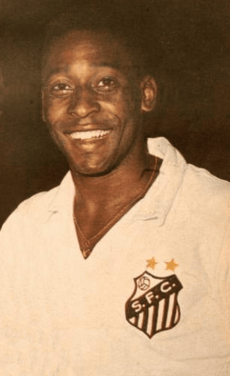
Pelé holds the record for playing the most games for Santos, with 1106 matches from 1956 to 1974. Pepe is second, having played 750 times. The goalkeeper with the most appearances is Agenor "Manga" Gomes, with 404 games. Five other players have played over 500 games: Zito (727), Lima (696), Dorval (612), Edú (584), and Clodoaldo (510).
Pelé is also Santos's all-time top goalscorer, with an incredible 1091 goals. Four other players have scored over 200 goals for Santos: Pepe (405), Coutinho (370), Toninho Guerreiro (283), and Feitiço (216).
Borges holds the record for the most goals scored in one Brasileirão season for the club (23 goals in 2011). Feitiço's 31 goals in the 1931 Campeonato Paulista was the one-season record in the Campeonato Paulista until Pelé scored 58 goals in 1958, a record that still stands. The highest home attendance for a Santos match was 132,728 fans in the Intercontinental Cup in 1963. Santos has also set records in Brazilian football, including the most national titles (8) and the most consecutive seasons won (5, from 1961 to 1965).
Santos is one of the most successful Brazilian teams in the Copa Libertadores, winning in 1962, 1963, and 2011. They are also the first Brazilian team to win the Copa Libertadores without losing a single match, which they did in 1963. In 1962, Santos won the Paulista, Taça Brasil, and the Copa Libertadores.
Other Sports Sections
Santos FC is mainly known for football, but it also has teams in other sports:
- Santos FC (women) (Women's Football)
- Santos FC Caratê (Karate)
- Santos FC Futebol de mesa (Table Football)
- Santos FC Futsal (Futsal - no longer active)
- Santos FC Golbol (Goalball)
- Santos FC Judô (Judo)
- Santos FC Taekwondo (Taekwondo)
- Santos FC Tênis de mesa (Table Tennis)
- Santos FC Tsunami (Volleyball)
- Santos FC Voleibol (Volleyball)
- Santos Dexterity (eSports)
See also
 In Spanish: Santos Futebol Clube para niños
In Spanish: Santos Futebol Clube para niños
- Santos FC and the Brazil national football team
- Santos FC (women)
- Santos FC (youth)
- Santos FC (beach soccer)
- Santos FC Futsal
- Santos FC Futebol de mesa
- Santos FC Judô
- Santos FC Caratê
- Torcida Jovem
- List of world champion football clubs
Movies About Santos FC
- Aníbal Massaini Neto, Pelé Eterno, 2004.
- Carlos Hugo Christensen, O Rei Pelé, 1963.
- Djalma Limongi Batista, Asa Branca: um sonho brasileiro, 1981.
- Eduardo Escorel and Luiz Carlos Barreto, Isto é Pelé, 1974.
- Felipe Nepomuceno, Guadalajara 70, 2002.
- Hank Levine, Marcelo Machado and Tocha Alves, Ginga, 2004.
- Lina Chamie, Santos 100 Anos de Futebol Arte, 2012.
- Mercado Livre, Santos, Especial, 2011.
- Paulo Machline, Uma história de futebol, 1998.
- Pedro Asbeg, Dogão calabresa, 2002.
- Ugo Giorgetti, Boleiros, 1998.


